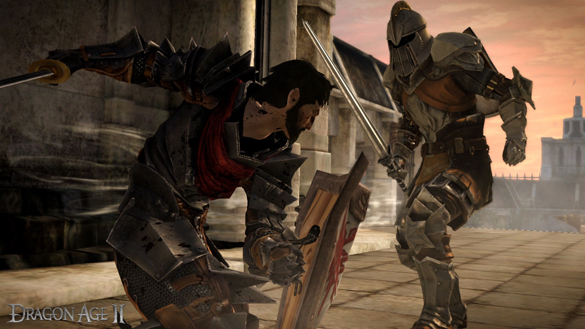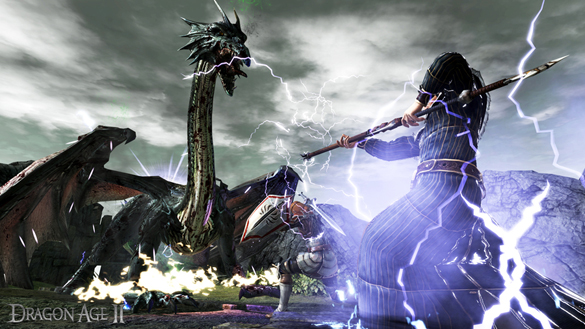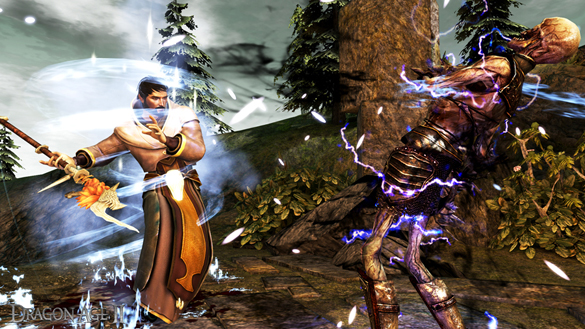Dragon Age 2: Dragon Harder

I’ve poured almost thirty hours into Dragon Age 2 since its release less than a week ago, and in that time I’ve been slowly getting a handle on what exactly I like and don’t like about the game. Narrative concerns I will probably leave for another day, but there were a few things I noticed:
Combat. There are occasions when the new camera system gets in the way, and honestly I’m not sure why they decided to change it from the old PC camera with the top-down view, which felt much, much better. As a console concession, it makes no sense because even Dragon Age: Origins gave the consoles a different camera. Watching the Giant Bomb Quick Look, which included footage from both the 360 and PC versions of the game, it’s clear Dragon Age 2 was tailored to some extent for each platform; the old-school camera could easily have been kept for the PC version. If the issue was that players often missed the more cinematic viewpoint you get from peering over Hawke’s shoulders—a less severe version of Batman: Arkham Asylum encouraging you to play the whole game in the monochromatic Detective Mode—then it would’ve been easy to turn off the top-down view until you enter a battle; clearly the game already recognizes the difference between combat and non-combat situations. Frankly, it’s a baffling change.
Aside from that major issue, combat feels only slightly different. Part of this may have to do with the characters I played in each game. In Origins, I played a sword-and-shield warrior, but because of my lack of experience with either MMOGs or old-school RPGs, I didn’t do the best job of turning her into a tank like she should’ve been; I’d often rely on Alistair to help with that department. Meanwhile, in Dragon Age 2, I’ve made my Hawke a rogue, which plays quite a bit differently than a warrior, so it’s harder to compare. There’s less walking up to an enemy and standing there until it’s gone, and more leaping back and forth between enemies, throwing decoys everywhere, and backstabbing everyone.
I get the vague impression that positioning around enemies matters less—in addition to area-of-effect spells not killing your characters with friendly fire, basic things like rogue backstabs rely less on position and more on activating talents. Battles seem to go on for longer than usual sometimes because of the tendency of the game to spawn waves of enemies at you; this gets supremely annoying in certain battles that don’t seem like they should be that hard, based on the experience they give you and their significance in the story. By and large, it’s the Dragon Age I remember from a year and a half ago, though that’s plenty of time to forget the intricacies of battle. I still haven’t played Dragon Age: Awakenings yet, so I may yet have the chance to do a more comprehensive comparison at some point.
Setting. One of the amazing things about Origins was its scope—between the Dalish clans, the dwarves at Orzammar, the Deep Roads, the mage towers, the cities of Ferelden and the vast swaths of wilderness connecting them, it felt like you got to see a ton of stuff in the original Dragon Age. The sequel tosses out that globetrotter feel in favour of a more intimate experience set in and around the city of Kirkwall. In some ways, it’s to the game’s benefit; one of Dragon Age 2’s biggest appeals is how the world and your companions evolve over time, something games don’t usually try to tackle. By limiting your surroundings, they become familiar more quickly, and so changes stand out a lot more—though generally speaking, it’s the people that change more than the look of the environments themselves.
In other ways, though, keeping everything confined to Kirkwall means repetition. A lot of repetition. A great deal of repetition. Perhaps too much repetition. The first Mass Effect was criticized for reusing the same small levels for all the exploration-based side missions; Dragon Age 2’s dungeons, though more intricately crafted than Mass Effect’s box mazes, are guilty of the same sin. It really takes you out of the fiction when the environment you saw inside Sundermount gets reused for an underground cave on the Wounded Coast, though you do get used to it after a while. It’s one of those problems that’ll bug you in hindsight for sure, but may or may not bother you when you’re actually playing the game. It does smack of either laziness, lack of resources or rushed deadlines, though.
The most egregious example of asset reuse was in one of the missions from the Exiled Prince DLC you get if you pre-ordered the Signature Edition of the game. The dungeons don’t really look like any of the ones in the main game, but as you walk through one of them, you might find it oddly familiar at first. Eventually you’ll realize that while the wallpaper is different and the drapes are a different colour, the actual layout of the dungeon is exactly the same. Why go to the trouble of building a new level if you’re just going to reuse the same layout? It’s more than a little bizarre.
Items. Because your companions now have preset armor that can’t be swapped out for new pieces, approximately two thirds of the armor pieces you run into will be useless to you, unless you’ve put a lot of Strength points into your mage for no apparent reason. Between this change and all the junk lying around that you can’t use except to sell off for gold, the loot aspect of the game is less interesting than it was in Origins—though Origins maybe gave you too much reason to keep loot around, especially considering you had to hold everything in your inventory unless you modded your game to add a storage chest.
Runes seem simplified this time around as well; basically, weapon and armor quality determine the effectiveness of a rune, and that’s it. No lesser or greater runes, and now that you can buy runes by the pocketful, no reason to hoard them (like I did for far too long until I understood this). Unfortunately, the runes are all pretty basic: add elemental damage, protect against elemental damage, increase damage, decrease damage, etc. It would’ve been nice to see some more creative effects like increased mana/stamina regen, one-time revives, or even temporary skills (though I can see how that last one could get complicated). Maybe I’m just spoiled by the Japanese RPGs I’ve played lately that offer a wide variety of effects and buffs.
[This also appeared over at Wesley’s Game Diary]






496683 582557I always was interested in this subject and nonetheless am, thankyou for posting . 465031